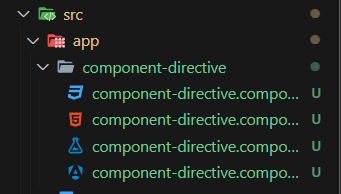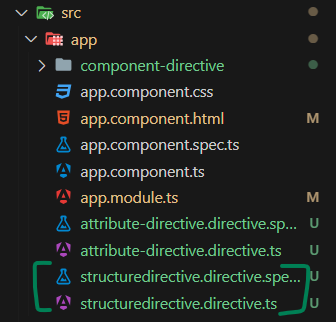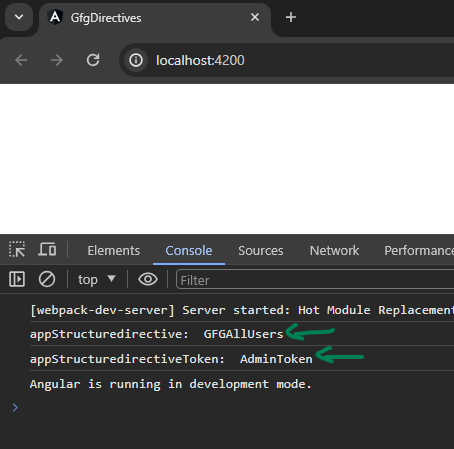|
Angular directives are TypeScript classes decorated with the @Directive decorator. These are powerful tools for manipulating the DOM and adding behavior to elements. They can modify the behavior or appearance of DOM elements within an Angular application.
Directives can be broadly categorized into three types:
- Component Directives: These are directives with a template and can be used as standalone components.
- Attribute Directives: These change the appearance or behavior of an element, component, or another directive.
- Structural Directives: These change the DOM layout by adding or removing elements.
We will discuss the following approaches to pass multiple parameter to @directives in Angular:
Steps to Create Angular ProjectStep 1: Create a new Angular project using the following command.
ng new gfg-directives Folder Structure:
 Project Structure of the new Angular application Dependencies:
"dependencies": {
"@angular/animations": "^17.3.0",
"@angular/common": "^17.3.0",
"@angular/compiler": "^17.3.0",
"@angular/core": "^17.3.0",
"@angular/forms": "^17.3.0",
"@angular/platform-browser": "^17.3.0",
"@angular/platform-browser-dynamic": "^17.3.0",
"@angular/router": "^17.3.0",
"rxjs": "~7.8.0",
"tslib": "^2.3.0",
"zone.js": "~0.14.3"
},
"devDependencies": {
"@angular-devkit/build-angular": "^17.3.0",
"@angular/cli": "^17.3.0",
"@angular/compiler-cli": "^17.3.0",
"@types/jasmine": "~5.1.0",
"jasmine-core": "~5.1.0",
"karma": "~6.4.0",
"karma-chrome-launcher": "~3.2.0",
"karma-coverage": "~2.2.0",
"karma-jasmine": "~5.1.0",
"karma-jasmine-html-reporter": "~2.1.0",
"typescript": "~5.4.2"
}Approach 1: Using Component DirectivesCreate a new component suing the following command.
ng generate component component-directive Folder Structure:
 Component Structure Code Example:
HTML
<!-- component-directive.component.html -->
<p>{{greetingMessage}}</p>
<!-- app.component.html -->
<app-component-directive
[firstName]="'Geeks'"
[lastName]="'ForGeeks'">
</app-component-directive>
//component-directive.component.ts
import { Component, Input } from '@angular/core';
@Component({
selector: 'app-component-directive',
templateUrl: './component-directive.component.html',
styleUrls: ['./component-directive.component.css']
})
export class ComponentDirectiveComponent {
@Input() firstName!: string;
@Input() lastName!: string;
greetingMessage = ""
ngOnInit() {
this.greetingMessage = `Welcome Back ${this.firstName}
${this.lastName}`
}
}
Output: Browser
Approach 2: Using Attribute DirectivesCreate a new directive using the following command
ng generate directive attribute-directive Folders Structure:
 Attribute Directive Structure Code Example:
HTML
<!-- app.component.html -->
<div appAttributeDirective [colorName]="'yellow'" [opacity]=0.4>
Hover over me to see the magic!
</div>
//attribute-directive.directive.ts
import { Directive, ElementRef, HostListener, Input } from '@angular/core';
@Directive({
selector: '[appAttributeDirective]'
})
export class AttributeDirectiveDirective {
constructor(private elementRef: ElementRef) { }
@Input() colorName!: string;
@Input() opacity!: number;
@HostListener('mouseenter') onMouseEnter() {
this.highlight(this.colorName, this.opacity);
}
@HostListener('mouseleave') onMouseLeave() {
this.highlight('', 1);
}
private highlight(color: string, opacity: number) {
this.elementRef.nativeElement.style.opacity = opacity;
this.elementRef.nativeElement.style.backgroundColor = color;
}
}
Output: Browser
Approach 3: Using Structural DirectivesCreate a new directive using the following coammand.
ng generate directive structuredirective Folder Structure:
 Structure Directive Code Example:
HTML
<!-- app.component.html -->
<div *appStructuredirective="'GFGAllUsers';token:'AdminToken'"></div>
//structuredirective.directive.ts
import { Directive, Input } from '@angular/core';
@Directive({
selector: '[appStructuredirective]'
})
export class StructuredirectiveDirective {
@Input()
set appStructuredirective(value: string) {
console.log('appStructuredirective: ', value);
}
@Input()
set appStructuredirectiveToken(value: string) {
console.log('appStructuredirectiveToken: ', value);
}
}
Output:
 Browser’s Console
|







